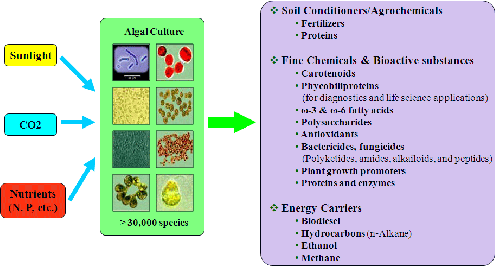Algae
Algae include cellular and micro-cellular plants that live in water. They conduct photosynthesis just like plants and store various forms of carbon. Algae has the potential to produce energy and other high value bioproducts.
Why algae?
- Algae can be grown on non-productive land
- Utilize waste CO2 streams (CO2 sequestration), which reduces global warming
- Algae utilizes nutrients in agricultural and municipal waste water and serves as a water treatment agent
- Non-food resources are used to produce it
- There is much greater Potential productivity than their terrestrial cousins
Table 1. Compartive productivity of selected biofuel crops.
|
Crop |
Productivity |
Energy |
|
Wheat (seed + straw) |
11 |
170 |
|
Miscanthus |
16 |
270 |
|
Switchgrass |
10 |
180 |
|
Microalgae (optimized) |
60 |
1200 |
|
Microalgae (Theoretical) |
120 |
2400 |
Algae has the potential for a wide range of value added energy and chemicals. This diversity in products is why algae has garnered so much attention in the news recently. Typically, people associate algae with production of biodiesel, but there are species that can be used to produce ethanol, hydrocarbons, fertilizer, proteins and other high value chemicals.
Figure 1. There are many species of algae that can create a diverse portfolio of products.

Links
Algal Biofuels - US DOE Factsheet - PDF (0.6 MB)
The Potential of Biofuels from Algae - NREL Presentation - PDF (1.0 MB)
Algae as a Biodiesel Feedstock: A Feasibility Assessment (PDF 1.4 MB)
Source: Liao, W. and Liu, S., Biosystems and Agricultural Engineering, Michigan State University.



 Print
Print Email
Email